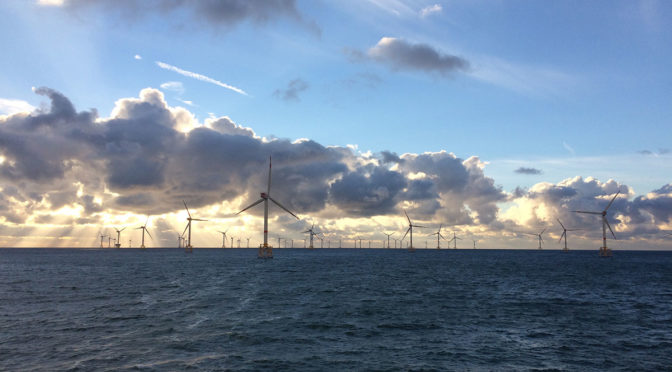Two major offshore wind farm projects off Massachusetts and Rhode Island are moving forward after selection in a clean energy procurement process conducted by the Commonwealth of Massachusetts in which Rhode Island participated.
The projects are Vineyard Wind’s proposed 800 megawatt (MW) offshore wind farm located 15 miles south of Martha’s Vineyard and Deepwater Wind’s 400-megawatt Revolution Wind project, 30 miles from the mainland and about 12 miles south of Martha’s Vineyard.
ineyard Wind is the winner of the Massachusetts tender for offshore wind energy projects. This means that the Massachusetts Electric Distribution Companies (EDCs) will now start negotiating contracts including a power purchase agreement (PPA) with Vineyard Wind.
Vineyard Wind is jointly owned by funds managed by the Copenhagen Infrastructure Partners (50%) and Avangrid/Iberdrola (50%) and seeks to build the first large-scale offshore wind farm in the United States, starting operations by late 2021.
In a statement released yesterday, Vineyard Wind said that “under Massachusetts law, the selection of Vineyard Wind by the EDCs and Department of Energy Resources (DOER) allows all parties to begin negotiations to secure all necessary transmission services and power purchase agreements to facilitate the delivery of offshore wind electricity to Massachusetts customers. Once satisfactory contract terms are secured, those documents will be submitted to the Massachusetts Department of Public Utilities for formal review.”
Vineyard Wind says that its proposal committed $15 million to three initiatives designed to make Massachusetts the center of the American offshore wind industry. The commitment includes a $10 million Wind Accelerator Fund to accelerate the development of an offshore wind supply chain, businesses, and infrastructure in the Bay State.
Governor Gina Raimondo announced yesterday that Rhode Island has selected Deepwater Wind, the Rhode Island-based clean energy developer, to construct a new, 400-megawatt offshore wind farm. The Revolution Wind project–more than ten times the size of the Block Island Wind Farm–was selected through a competitive offshore wind procurement process in collaboration with Massachusetts.
“Rhode Island made history when we built the first offshore wind farm in the United States,” said Governor Gina M. Raimondo. “Today, we are doing it again. This new, large-scale offshore wind project will bring clean and low-cost power to Rhode Islanders and further diversify our energy resources–all while adding good-paying jobs to our growing economy.”
“Rhode Island pioneered American offshore wind energy, and it’s only fitting that the Ocean State continues to be the vanguard of this growing industry,” said Deepwater Wind CEO Jeffrey Grybowski. “We applaud Governor Raimondo for her bold commitment to a clean energy future. We are building a new industry here in Rhode Island while driving down the cost of clean energy. Revolution Wind will mean lots of jobs for Rhode Island and major investments in local infrastructure.”
Deepwater Wind’s Revolution Wind project was selected through Rhode Island’s participation in a clean energy procurement process conducted by the Commonwealth of Massachusetts. Rhode Island state agencies, including the Office of Energy Resources and the Division of Public Utilities and Carriers, independently evaluated the proposals.
In March 2017, Governor Raimondo set a goal for Rhode Island to increase its clean energy resources portfolio ten-fold by 2020 to reach a total of 1,000 megawatts. Today’s announcement represents a significant step toward achieving that goal.
Not to be outdone, New Jersey also used yesterday to move offshore wind forward. Gov. Phil Murphy signed into law a 3,500 megawatt state goal that the legislature had recently passed. That’s the largest state commitment to date, and the latest in the crescendoing drumbeat of state action on offshore wind.
And the first tranche of Garden State action may be even larger than what Massachusetts and Rhode Island just moved forward on. Just after coming into office, Gov. Murphy ordered the state’s public utility commission to carry out a solicitation for 1,100 megawatts of offshore wind.
While megawatts may be the stuff of headlines, each of those projects and commitments is about a lot more—jobs in the near term, and air quality improvements, carbon reductions, careers, and more once the projects are up and running.
What’s next?
All that is particularly true as even more states get into the act. So where should we look next for leadership on offshore wind?
Connecticut could be poised to join its neighbors as it makes decisions about proposals for meeting its own renewable energy needs. The bids included proposals from Vineyard Wind and Deepwater Wind, plus Bay State Wind, the other entity vying for the Massachusetts and Rhode Island attention.
It’s also unlikely that New York is going to stay quiet, given its new offshore wind master plan, a 96 megawatt project planned for off Long Island’s South Fork (also being developed by Deepwater), the record-breaking lease sale off New York City in late 2016, and federal moves to evaluate more potential sites in the New York Bight.
Or we could be hearing more from Maryland, with two projects making their way forward with state support. Or Virginia, with a pilot 12 megawatt project. Or Delaware, or North Carolina, or…
Lots of future to watch—and make happen—even as we celebrate the immediate past. Because, given our need for clean energy and good jobs, and given the incredible potential of offshore wind, we’ll be wanting a lot more days like yesterday.

